Santa Cruz Island
At daybreak we observed the panoramic view of Puerto Ayora in the near distance. This is the largest town in the archipelago and home of the Charles Darwin Research Station (CDRS). In this Centre we learned about the educational, research and conservation programs run by the CDRS and the Galápagos National Park (GNP). One of the best known programs is the one dedicated to the incubation and repatriation of endangered subspecies of Galápagos Giant Tortoises to their islands of origin. The recent history of these majestic reptiles is unfortunately tragic. Hundreds of thousands were removed from the islands in the last centuries. Pirates, buccaneers, whalers, sealers, and even the first colonists used the abundant meat found in these humongous tortoises as a food supply. It is known that these giant tortoises can survive for up to two years without eating or drinking. They were transported like living meat boxes. In times where refrigeration was still far to be invented to use this fresh meat in the middle of the long journeys became popular among sea people. Many giant tortoise populations were severely affected for their numbers were drastically reduced.
One of the iconic individuals found in the Centre is “Lonesome George” from Pinta Island. Despite his catchy nickname, he is not that lonely; his time and space is shared with two females from Wolf volcano on Isabela Island. He is the last living surviving tortoise from Pinta Island. For longer than seventeen years we have been waiting for George to reproduce with the females that live with him. Just recently we had great news; some of the best news I have received in my life! Eggs were found finally in George’s enclosure! This news travelled all over the world and now we are waiting for the baby tortoises to hatch. In the early 1970's the Ecuadorian Government through the CDRS and the GNP was trying to locate in the many Zoos and collections of the World a companion for George. Around the same time, it was detected that on Hood Island there were only fourteen giant tortoises surviving! Twelve were females and two were males. Another famous tortoise individual came to the scene, “Diego”. This giant tortoise was sent back from San Diego Zoo. He turned out to be tortoise number fifteen of this subspecies. He has helped greatly to increase the population of Hood Island tortoises. He is an active and vital part of one of the most successful breeding programs in captivity worldwide. You can see Diego in the pictures of today standing proud and happy looking for a better future. George’s and Diego’s stories are fascinating and encouraging, letting us know that we as human beings can positively work to restore the damage we have made to the natural world in the past. Titanic efforts from individuals and organizations let us see a brighter future for our planet.
At daybreak we observed the panoramic view of Puerto Ayora in the near distance. This is the largest town in the archipelago and home of the Charles Darwin Research Station (CDRS). In this Centre we learned about the educational, research and conservation programs run by the CDRS and the Galápagos National Park (GNP). One of the best known programs is the one dedicated to the incubation and repatriation of endangered subspecies of Galápagos Giant Tortoises to their islands of origin. The recent history of these majestic reptiles is unfortunately tragic. Hundreds of thousands were removed from the islands in the last centuries. Pirates, buccaneers, whalers, sealers, and even the first colonists used the abundant meat found in these humongous tortoises as a food supply. It is known that these giant tortoises can survive for up to two years without eating or drinking. They were transported like living meat boxes. In times where refrigeration was still far to be invented to use this fresh meat in the middle of the long journeys became popular among sea people. Many giant tortoise populations were severely affected for their numbers were drastically reduced.
One of the iconic individuals found in the Centre is “Lonesome George” from Pinta Island. Despite his catchy nickname, he is not that lonely; his time and space is shared with two females from Wolf volcano on Isabela Island. He is the last living surviving tortoise from Pinta Island. For longer than seventeen years we have been waiting for George to reproduce with the females that live with him. Just recently we had great news; some of the best news I have received in my life! Eggs were found finally in George’s enclosure! This news travelled all over the world and now we are waiting for the baby tortoises to hatch. In the early 1970's the Ecuadorian Government through the CDRS and the GNP was trying to locate in the many Zoos and collections of the World a companion for George. Around the same time, it was detected that on Hood Island there were only fourteen giant tortoises surviving! Twelve were females and two were males. Another famous tortoise individual came to the scene, “Diego”. This giant tortoise was sent back from San Diego Zoo. He turned out to be tortoise number fifteen of this subspecies. He has helped greatly to increase the population of Hood Island tortoises. He is an active and vital part of one of the most successful breeding programs in captivity worldwide. You can see Diego in the pictures of today standing proud and happy looking for a better future. George’s and Diego’s stories are fascinating and encouraging, letting us know that we as human beings can positively work to restore the damage we have made to the natural world in the past. Titanic efforts from individuals and organizations let us see a brighter future for our planet.



